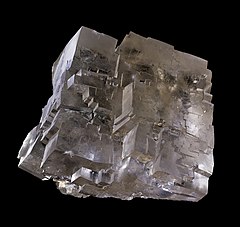Rock salt
| Halite | |
|---|---|

Halite from the Wieliczka salt mine, Małopolskie, Poland
|
|
| General | |
| Category | Halide mineral |
|
Formula (repeating unit) |
NaCl |
| Strunz classification | 3.AA.20 |
| Crystal system | Cubic |
| Crystal class | Hexoctahedral (m3m) H-M symbol: (4/m 3 2/m) |
| Space group | Fm3m |
| Unit cell | a = 5.6404(1) Å; Z = 4 |
| Identification | |
| Formula mass | 58.433 g/mol |
| Color | Colorless or white |
| Crystal habit | Predominantly cubes and in massive sedimentary beds, but also granular, fibrous and compact |
| Cleavage | Perfect {001}, three directions cubic |
| Fracture | Conchoidal |
| Tenacity | Brittle |
| Mohs scale hardness | 2.0 - 2.5 |
| Luster | Vitreous |
| Streak | White |
| Diaphaneity | Transparent |
| Specific gravity | 2.17 |
| Optical properties | Isotropic |
| Refractive index | n = 1.544 |
| Solubility | Water-soluble |
| Other characteristics | Salty flavor, Fluorescent |
| References | |
Halite (pronunciation: /ˈhælaɪt/ or /ˈheɪlaɪt/), commonly known as rock salt, is a type of salt, the mineral form of sodium chloride (NaCl). Halite forms isometric crystals. The mineral is typically colorless or white, but may also be light blue, dark blue, purple, pink, red, orange, yellow or gray depending on the amount and type of impurities. It commonly occurs with other evaporite deposit minerals such as several of the sulfates, halides, and borates.
Halite occurs in vast beds of sedimentary evaporite minerals that result from the drying up of enclosed lakes, playas, and seas. Salt beds may be hundreds of meters thick and underlie broad areas. In the United States and Canada extensive underground beds extend from the Appalachian basin of western New York through parts of Ontario and under much of the Michigan Basin. Other deposits are in Ohio, Kansas, New Mexico, Nova Scotia and Saskatchewan. The Khewra salt mine is a massive deposit of halite near Islamabad, Pakistan. In the United Kingdom there are three mines; the largest of these is at Winsford in Cheshire producing on average a million tonnes per year.
...
Wikipedia
